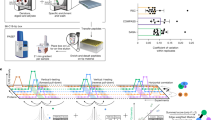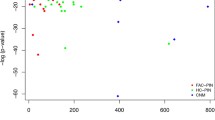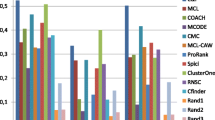Abstract
We describe an approach to clustering the yeast protein-protein interaction network in order to identify functional modules, groups of proteins forming multi-protein complexes accomplishing various functions in the cell. We have developed a clustering method that accounts for the small-world nature of the network. The algorithm makes use of the concept of k-cores in a graph, and employs recursive spectral clustering to compute the functional modules. The computed clusters are annotated using their protein memberships into known multi-protein complexes in the yeast. We also dissect the protein interaction network into a global subnetwork of hub proteins (connected to several clusters), and a local network consisting of cluster proteins.
Research supported by NSF grant CCR0306334, by subcontract B542604 from the Lawrence Livermore National Laboratory, and by a grant from the Office of Research at Old Dominion University.
Preview
Unable to display preview. Download preview PDF.
Similar content being viewed by others
References
Gavine, A.-C., Bosche, M., Krause, R., et al.: Functional organization of the yeast proteome by systematic analysis of protein complexes. Nature 415, 141–147 (2002)
Achsel, T., et al.: The Sm domain is an ancient RNA-binding motif with oligo(U) specificity. Procs. Natl. Acad. Sci. 98, 3685–3689 (2001)
Angenstein, F., et al.: A receptor for activated C kinase is part of messenger ribonucleoprotein complexes associated with polyA-mRNA in neurons. J. Neurosci. 22, 8827–8837 (2002)
Bader, G.D., Hogue, C.W.: An automated method for finding molecular complexes in large protein interaction networks. BMC Bioinformatics 4(2), 27 (2003)
Bi, X., Goss, D.: Wheat germ poly (A)-binding protein increases ATPase and the RNA helicase activity of translation initiation factors eIF4A, eIF4B and eIF-iso-4F. J. Biol. Chem. 275, 17740–17746 (2000)
Bornholdt, S., Schuster, H.G. (eds.): Handbook of Graphs and Networks. Wiley VCH, Chichester (2003)
Chung, F., Lu, L.: The average distances in random graphs with given expected degrees. Procs. Natl. Acad. Sci. 99(25), 15879–15882 (2002)
Dhillon, I.S.: Co-clustering documents and words using bipartite spectral graph partitioning. In: Procs. ACM Internatl. Conf. Knowledge Discovery in Data Mining (KDD) (2001)
Ding, C., He, X., Meraz, R.F., Holbrook, S.R.: A unified representation of multi-protein complex data for modeling interaction networks. Proteins: Structure, Function, and Genetics (2004) (to appear)
Ding, C., He, X., Zha, H., Gu, M., Simon, H.: A MinMaxCut spectral method for data clustering and graph partitioning. In: Procs. IEEE Internatl. Conf. Data Mining (ICDM), pp. 107–114 (2001)
Fromont-Racine, M., et al.: Genome-wide protein interaction screens reveal functional networks involving Sm-like proteins. Yeast 17, 95–110 (2000)
Galisson, F., Legrain, P.: The biochemical defects of PRP4-1 and PRP6-1 yeast splicing mutants reveal that the PRP6 protein is required for the accumulation of the [U4/U6.U5] tri-snRNP. Nucl. Acids Res. 21, 1555–1562 (1993)
Han, J.D.J., Dupuy, D., Bertin, N., et al.: Effect of sampling on topology predictions of protein-protein interaction networks. Nature Biotechnology 23, 839–844 (2005)
Hartwell, L.H., Hopfeld, J.J., Leibler, S., Murray, A.W.: From molecular to modular cell biology. Nature 402, C47–C52 (1999)
Ho, Y., Gruhler, A., Heilbut, A., et al.: Systematic identification of protein complexes in Saccharomyces cerevisiae by mass spectrometry. Nature 415, 180–193 (2002)
Ito, T., Chiba, T., Ozawa, R., et al.: A comprehensive two hybrid analysis to explore the yeast protein interactome. Procs. Natl. Acad. Sci. 98, 4569–4574 (2001)
Jarvis, A.A., Patrick, E.A.: Clustering based on a similarity measure based on shared nearest neighbors. IEEE Trans. Computers C-22, 1025–1034 (1973)
Noble, C., et al.: Rna14-Rna15 assembly mediates the RNA-binding capability of Saccharomyces cerevisiae cleavage factor IA. Nucl. Acids Res. 32, 3364–3375 (2004)
Ramadan, E., Tarafdar, A., Pothen, A.: A hypergraph model for the yeast protein complex network. In: Procs. Workshop High Performance Computational Biology (HICOMB), p. 8. IEEE / ACM, Los Alamitos (2004) (CDROM)
Rymond, B.C.: Convergent transcripts of the yeast PRP38-SMD1 locus encode two essential splicing factors, including the D1 core polypeptide of small nuclear ribonucleoprotein particles. Procs. Natl. Acad. Sci. 90, 848–852 (1993)
Spirin, V., Mirny, L.A.: Protein complexes and functional modules in molecular networks. Procs. Natl. Acad. Sci. 100, 12123–12128 (2003)
Tan, P., Steinbach, M., Kumar, V.: Introduction to Datamining. Addison Wesley, Reading (2005)
Urushiyama, S., et al.: The prp1+ gene required for pre-mRNA splicing in Schizosaccharomyces pombe encodes a protein that contains TPR motifs and is similar to Prp6p of budding yeast. Genetics 147, 101–115 (1997)
Author information
Authors and Affiliations
Editor information
Editors and Affiliations
Rights and permissions
Copyright information
© 2005 Springer-Verlag Berlin Heidelberg
About this paper
Cite this paper
Ramadan, E., Osgood, C., Pothen, A. (2005). The Architecture of a Proteomic Network in the Yeast. In: R. Berthold, M., Glen, R.C., Diederichs, K., Kohlbacher, O., Fischer, I. (eds) Computational Life Sciences. CompLife 2005. Lecture Notes in Computer Science(), vol 3695. Springer, Berlin, Heidelberg. https://doi.org/10.1007/11560500_24
Download citation
DOI: https://doi.org/10.1007/11560500_24
Publisher Name: Springer, Berlin, Heidelberg
Print ISBN: 978-3-540-29104-6
Online ISBN: 978-3-540-31726-5
eBook Packages: Computer ScienceComputer Science (R0)




